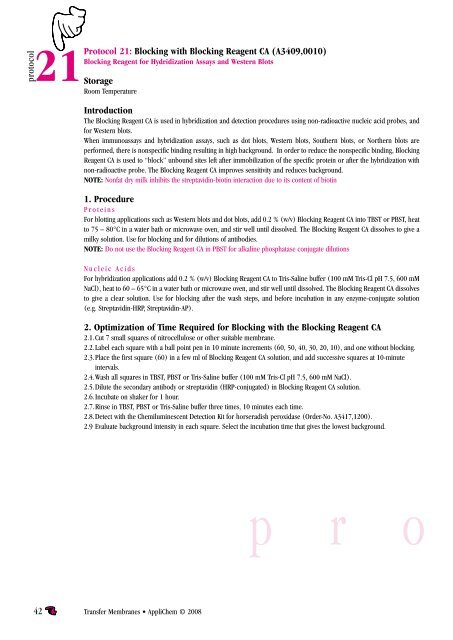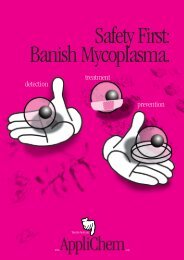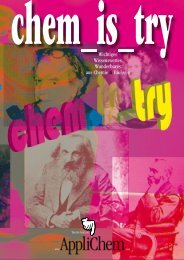Transfer Membranes
Transfer Membranes
Transfer Membranes
You also want an ePaper? Increase the reach of your titles
YUMPU automatically turns print PDFs into web optimized ePapers that Google loves.
protocol<br />
21<br />
Protocol 21: Blocking with Blocking Reagent CA (A3409,0010)<br />
Blocking Reagent for Hydridization Assays and Western Blots<br />
Storage<br />
Room Temperature<br />
Introduction<br />
The Blocking Reagent CA is used in hybridization and detection procedures using non-radioactive nucleic acid probes, and<br />
for Western blots.<br />
When immunoassays and hybridization assays, such as dot blots, Western blots, Southern blots, or Northern blots are<br />
performed, there is nonspecific binding resulting in high background. In order to reduce the nonspecific binding, Blocking<br />
Reagent CA is used to “block” unbound sites left after immobilization of the specific protein or after the hybridization with<br />
non-radioactive probe. The Blocking Reagent CA improves sensitivity and reduces background.<br />
Note: Nonfat dry milk inhibits the streptavidin-biotin interaction due to its content of biotin<br />
1. Procedure<br />
P r o t e i n s<br />
For blotting applications such as Western blots and dot blots, add 0.2 % (w/v) Blocking Reagent CA into TBST or PBST, heat<br />
to 75 – 80°C in a water bath or microwave oven, and stir well until dissolved. The Blocking Reagent CA dissolves to give a<br />
milky solution. Use for blocking and for dilutions of antibodies.<br />
Note: Do not use the Blocking Reagent CA in PBST for alkaline phosphatase conjugate dilutions<br />
N u c l e i c A c i d s<br />
For hybridization applications add 0.2 % (w/v) Blocking Reagent CA to Tris-Saline buffer (100 mM Tris-Cl pH 7.5, 600 mM<br />
NaCl), heat to 60 – 65°C in a water bath or microwave oven, and stir well until dissolved. The Blocking Reagent CA dissolves<br />
to give a clear solution. Use for blocking after the wash steps, and before incubation in any enzyme-conjugate solution<br />
(e.g. Streptavidin-HRP, Streptavidin-AP).<br />
2. Optimization of Time Required for Blocking with the Blocking Reagent CA<br />
2.1. Cut 7 small squares of nitrocellulose or other suitable membrane.<br />
2.2. Label each square with a ball point pen in 10 minute increments (60, 50, 40, 30, 20, 10), and one without blocking.<br />
2.3. Place the first square (60) in a few ml of Blocking Reagent CA solution, and add successive squares at 10-minute<br />
intervals.<br />
2.4. Wash all squares in TBST, PBST or Tris-Saline buffer (100 mM Tris-Cl pH 7.5, 600 mM NaCl).<br />
2.5. Dilute the secondary antibody or streptavidin (HRP-conjugated) in Blocking Reagent CA solution.<br />
2.6. Incubate on shaker for 1 hour.<br />
2.7. Rinse in TBST, PBST or Tris-Saline buffer three times, 10 minutes each time.<br />
2.8. Detect with the Chemiluminescent Detection Kit for horseradish peroxidase (Order-No. A3417,1200).<br />
2.9 Evaluate background intensity in each square. Select the incubation time that gives the lowest background.<br />
p r o<br />
42 <strong>Transfer</strong> <strong>Membranes</strong> • AppliChem © 2008





